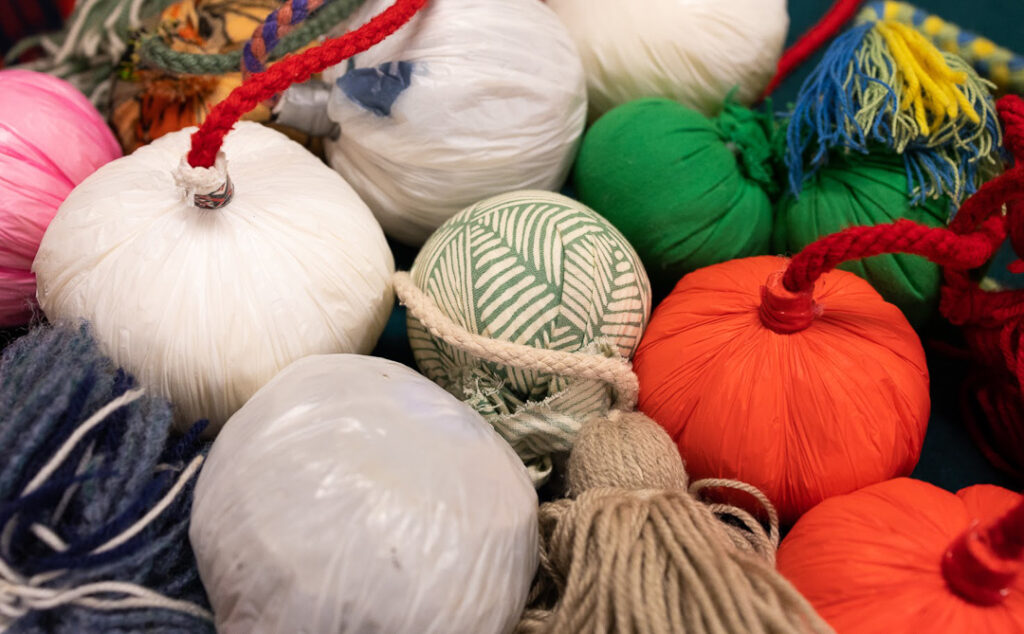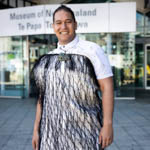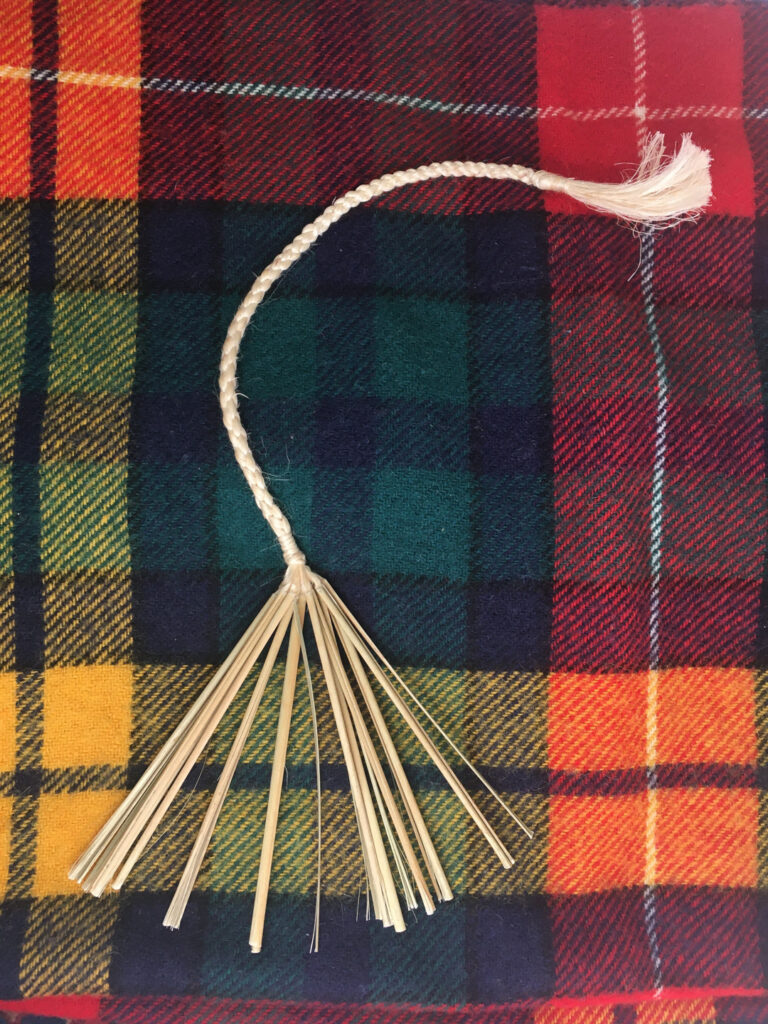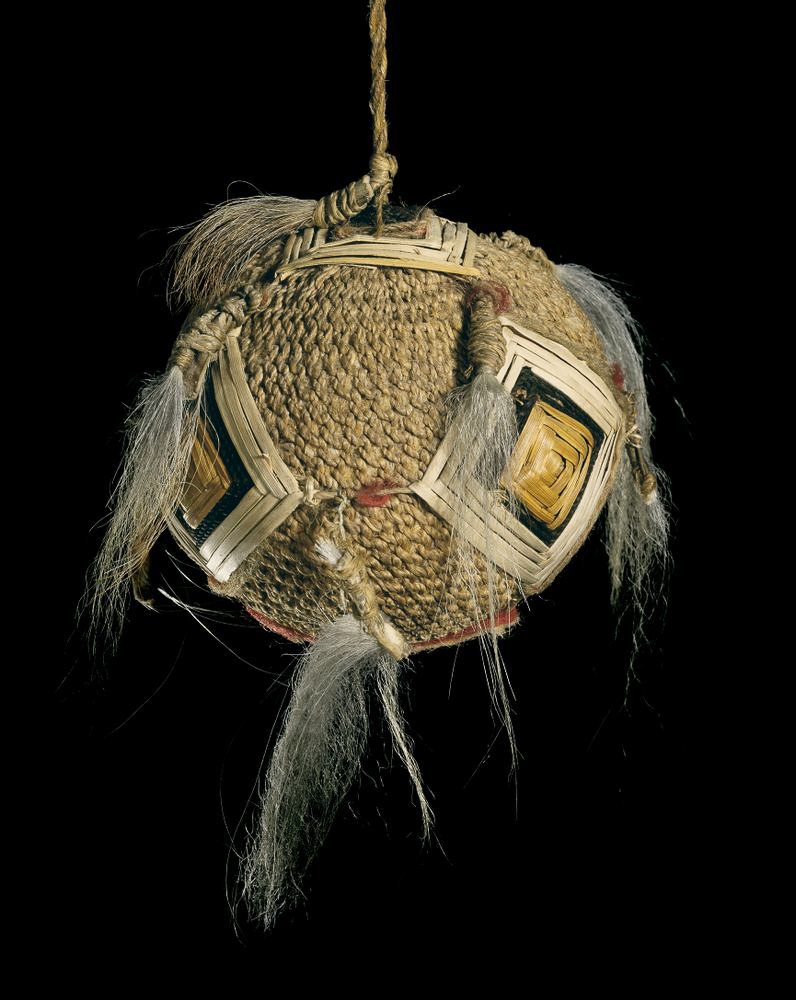
Contemporary Poi, Poi of Te Āteanui Pūoro Tira, 2023, plastic, fabric, wool. Courtesy of Sam Palmer.
For Isaac Te Awa, poi is not only an accessory for dazzling performances, it is also a traditional Māori instrument used for practical and cultural reasons in itself.
I have always found something hypnotic about seeing poi in flight. The grace, beauty and sound that can be coaxed from them has enticed Māori for generations. Today, poi is one of the most recognised and widespread of all Māori art forms. Poi has continued to be practised here in Aotearoa in a variety of cultural and customary contexts. However, the elegance of poi has also enticed foreign audiences, spreading this taonga abroad with modern incarnations such as fire and glow poi. This journey has led to poi being found world-wide. But this humble art form has its roots firmly in the whenua and traditions of us as Māori in Aotearoa.
When most people think of poi, they will likely think of the plastic bag or fabric poi that is commonly seen on the kapa haka stage where the practised finesse and synchronised motion of multiple poi are paired with rhythmic thrum and singing voices in a performance-based concert style. Now seen as traditional, this concert style of poi is a beautiful example of how poi have changed over time, with modern white plastic adding a visual element that can be seen from a distance, or on camera. On the inside of the poi, foam or dacron stuffing is soft on the hands and amplifies the sound, while vibrantly dyed wool adds tantalizing colours and attractive tassels to the handles. Like its Māori inventors, poi and its usage has always been highly adaptable with material changes, ways of usage, and methods of creation changing and developing as the concept of poi came into contact with new technology and places. For example, as New Zealand moves towards the restriction and banning of plastic bags, poi-making is again undergoing a transitional process with new and old materials and methods being investigated to inform the practice of modern makers.
I am a Māori maker of poi, and like many other makers today, my practice has been directly influenced and informed by taonga tuturu; the treasures of the past that have been left behind by our ancestors. These masterpieces were equal parts functional objects and bespoke nuanced artworks. They were made using the unique materials and resources that were available from the local environment and its treasured and individual resources, making these taonga the fingerprints of the times, people, and whenua they originate from. As reflected by these taonga of the past, the form and use of poi were once more diverse than we commonly see today which can be viewed with a sense of loss as well as an opportunity to unveil the inspiration at the core of these taonga.
Prior to contact with Europeans, the poi raupō was the most common type of poi and many historical examples have survived to the present day. These poi are created using the spongy leaves of the raupō or bullrush commonly available from waterways and wetlands. The long leaves were wrapped around the fluffy cotton-like down of the raupō flower creating a soft spongey interior that allowed sound to travel. Simple cords of twined or braided muka (New Zealand flax fibre) were attached as handles. These poi varied in size, length and decoration, but are the closest historical example to the modern percussion instrument poi we see used in kapa haka today.
Poi were once an integrated part of everyday life with their use spanning the realms of music, health, combat, spirituality, storytelling, and entertainment. They hold a special place in the family of taonga pūoro or traditional Māori instruments. However, this translation of taonga pūoro can sometimes be misleading as the practice is as much a practice of spiritual belief and relationship with the environment as it is a musical one. As taonga pūoro which was banned in part because of its spiritual connotations, some forms of poi and the knowledge systems surrounding them were actively suppressed as a part of the colonisation process and was at risk of being forgotten.
- Poi Āwhiowhio Hue (calabash), by unknown maker. Bequest of Kenneth Athol Webster, 1971. Te Papa (WE000901)
- Isaac Te Awa, Poi Toroa, 2022, Raupō, muka, toroa feather.
- Poi Raupō, by unknown maker. Unknown Acquisition History. Te Papa (ME023887/2)
- Alice Spittle, Ipu Kōrero, 2021, harakeke (New Zealand flax). Photo Courtesy of Ruby Solly.
- Poi Awe, by unknown make. Unknown Acquisition History, Te Papa (ME000150).
- Poi Tāniko, Isaac Te Awa, Poi Tāniko, 2019. Muka (New Zealand Flax Fibre), duck feathers, dye.
Made from a hollowed hue or gourd, the poi āwhiowhio is an example of one of these treasures that was almost lost to colonisation. This taonga is sacred to Hine-Pū-Te-Hue, an atua or deity of peace. When swung, these gourd-based poi produce a variety of calming sounds that emulate birds such as the kererū or native wood pigeon with calls ranging from chattering to whistling. When used by skilled players, these soothing sounds can be used to coax and attract birds for entertainment or hunting. Another taonga in the realm of poi is the poi piu, or the ipu kōrero as they are more commonly known by practitioners. Ipu kōrero are another example of a kind of poi within taonga pūoro that almost disappeared. These taonga are woven from the curled and dried leaves of harakeke (New Zealand flax) and occupy the space between the poi raupō and a rattle, with oral narratives strongly linking them to the practice of storytelling and traditional chants or mōteatea.
At its core, poi is a holistic practice with depths that extends far beyond the sounds they can produce. They are recognised for their physical benefits, with poi weighted with rocks once used by warriors to increase their wrist strength, dexterity and spatial awareness. Poi are also utilised in health and wellness where they play a role in rehabilitation and recovery for the treatment of conditions like arthritis. Some variations like the poi awe transcended the physical realm, allowing them to be utilised for mindfulness and spiritual well-being.
Poi awe are named for the tufts of white dog hair that adorn them. These poi are woven from fine muka cord using a knotless netting technique. The completed ball is adorned with woven diamond-like patterns known as papakirango, or karu atua. The meaning of these patterns can vary by iwi or tribe, but they are commonly associated with mourning, atua (deities), or whenua (land). These special poi were used ritually including during funerals as part of the spiritual grieving process. Although these poi are rare today, they are undergoing a revival process due to the research of dedicated makers and researchers.
The poi tāniko is another type of poi that has undergone a rapid revival in recent years. Like the poi awe, their use crossed into the ritual space. These rare yet highly adorned poi were woven using the tāniko technique which required time, skill, and patience to weave. Older examples of this form are relatively rare and their revival has been achieved through the work of dedicated and aspiring learners careful study, experimentation and creativity.
Today, many people think of the poi as an art form within the taha wāhine or, or an art based within the female realm. But it is important to note that poi are used by all genders in te ao Māori, both historically and through to the modern poi practice of today. Poi is a craft that encourages expression, both within the making, and the using of this taonga that we trace back to Hine-te-Iwaiwa, atua of female fertility and birth, as well as weaving. Through the weaving together of all the different aspects and uses of poi, we continue to bring Hine-te-Iwaiwa and the atua with us from the past into the modern world.
The range of poi that have been crafted and used across history and into our modern lives is far more vast than can be included here. Poi has ancient roots that have grown far and wide across Aotearoa, and across the world. Some of these poi and their crafting techniques are known to us, while others await discovery from within private museums and collections, with some existing only in kōrero and song, awaiting a weaver or creative to reimagine them back into existence. Like our ancestors, contemporary makers continue to draw from the resources and environment around them to create new poi that ensure that this living taonga and art form will be here for us and generations to come.
A kapahaka/fabric poi, a ipu kōrero, and Poi Āwhiowhio performed by Ruby Solly
About Isaac Te Awa
 Isaac Te Awa (Ngāpuhi, Kāti Māmoe, Kāi Tahu, Waitaha) works by day as a Curator Mātauranga Māori at Te Papa Tongarewa – Museum of New Zealand. He has diverse interests across te ao Māori, with a passion for reconnecting taonga to their people, places, and communities. He is an active practitioner of both Māori weaving and carving, with a special interest in the revival and documentation of traditional knowledges, techniques, and their practice. As a child, Isaac was privileged to learn weaving at the feet of his koro, and as an adult he has been taught and mentored by a wide range of teachers and life experiences that have enabled him to make the taonga he creates today.
Isaac Te Awa (Ngāpuhi, Kāti Māmoe, Kāi Tahu, Waitaha) works by day as a Curator Mātauranga Māori at Te Papa Tongarewa – Museum of New Zealand. He has diverse interests across te ao Māori, with a passion for reconnecting taonga to their people, places, and communities. He is an active practitioner of both Māori weaving and carving, with a special interest in the revival and documentation of traditional knowledges, techniques, and their practice. As a child, Isaac was privileged to learn weaving at the feet of his koro, and as an adult he has been taught and mentored by a wide range of teachers and life experiences that have enabled him to make the taonga he creates today.







